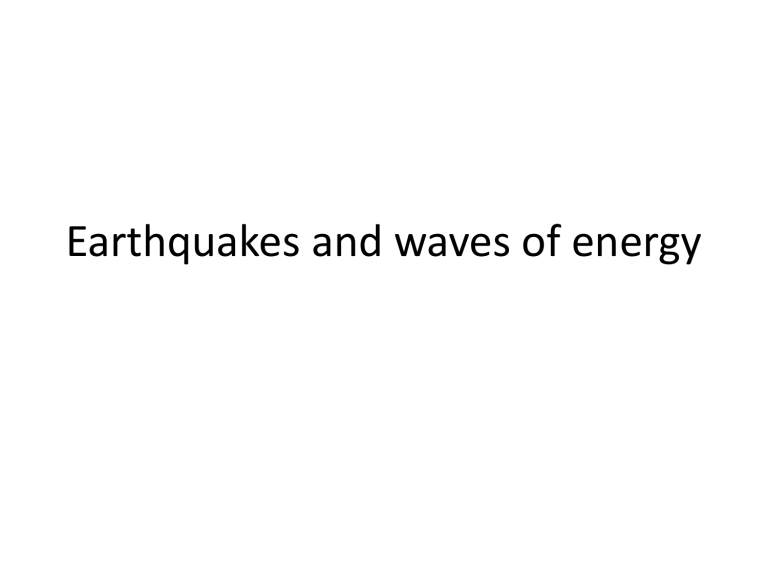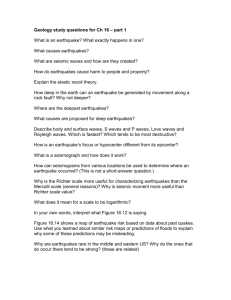Earthquakes and waves of energy

Earthquakes and waves of energy
Learning Target:
: I am learning how to analyze data in order to predict changes on the Earth’s surface. The purpose of this is to understand why we have earthquakes, volcanic eruptions, mid-ocean ridges and mountains.
Today I am learning about earthquakes and the energy and how this wave (force) moves within the lithosphere.
CW: Waves of Energy and their motion.
HW:
Final copy … Reflection
• Please get it out.
• Make sure to have a colored cover sheet.
• What do you do tonight?
– Take home your science notebook and…. Discuss the plate tectonic unit with a grown up
– As, have them read your C.E.R. Reflection
– Make sure to have your grown-up
comment
and
sign
your cover sheet.
• Any
Questions???
Plate Boundaries- Pod Chat
• Plates move three different way…. Make sure each of your pod members can show me how each plate boundary moves.
• Now add with each movement a brief description of what geological features each movement makes on the earths surface.
Create each plate boundary and identify what the geological features made by each plate boundary .
• Divergent:
• Oceanic & Oceanic: Mid-Oceanic Ridges, volcanoes, earthquakes, new seafloor and widens the ocean basin.
• Continental & Continental : Earthquakes, sinking rift valley, and a new ocean basin.
• Convergent:
• Oceanic & Continental: Trenches, volcanoes, mountain ranges deep earthquakes
• Oceanic & Oceanic: magma chambers, trenches, volcanoes, deep earthquakes, and eventually landmasses
• Continental & Continental : Folding and faulting of the crust, mountain ranges, and shallow earthquakes
• Transform:
!!!!!!!! EARTHQUAKES !!!!!!!!!
Review continues….
1. Two plates collide with each other at a.
Divergent boundary b.
Convergent boundary c.
The boundary between the mantle & the crust d.
A transform boundary
2. Volcanoes can occur at subduction zones. in convergent boundaries? True or False
3. What type of boundary is this picture?
a.
Divergent boundary b.
Convergent boundary c.
The boundary between the mantle & the crust d.
A transform boundary
4. What type of boundary forms mountains?
a.
Divergent boundary b.
Convergent boundary c.
The boundary between the mantle & the crust d.
A transform boundary
Transform Boundaries and their…
Energy
How many different ways can a slinky move like an earthquake?
Slinky and earth’s waves
Longitudinal Wave
• Version 1(lite version)
– Have everyone hold hands and pass a hand squeeze down the line.
• Version 2 (rowdy version)
– Have everyone stand shoulder to shoulder and pass a shoulder push (shove) down the line.
Longitudinal Wave
Longitudinal Waves move left and right. Sound waves are longitudinal waves.
Longitudinal waves are also called P waves (Primary) are also know as compressional waves, because of their pushing and pulling. Travels very fast and can go through solid, liquid and gasses.
“Wave” Movement Practice
• 1, “The Wave”.
• 2. Everybody lines up shoulder to shoulder.
• 3. You move only when the person on your left moves, etc.
• 4. Practice the wave a few times.
Transvers Movement
• First we will move just our hands a few inches up and down.
• Then only are arms up and down.
• Then are whole bodies up and down.
Transverse Wave
Transverse waves light and other electromagnetic waves are transverse waves.
Transverse wave is the S wave or secondary wave which is the second wave you feel in an earthquake. Travels much slower and can only go through solids! (shear wave)
Do you think the energy in the earth just moves the two ways we have demonstrated?
• What would it look like if we combined the longitudinal and the transvers waves together?
Rayleigh Waves
Some waves cannot be described as only longitudinal or transverse. A combination of the two waves would be the Rayleigh Wave. Rayleigh Waves are surface waves where a waves roll along the ground just like a wave rolls across a lake or an ocean.
Because it rolls, it moves the ground up and down , and side-to-side . Most of the
Shaking felt in an earthquake is due to the Rayleigh wave, which can be much larger than the other waves.
Love waves
The Love wave is the first kind of surface wave during an earthquake. The Love
Wave is the fastest surface wave and moves the ground from side-to-side.
Closure:
So the earth is moving…. Identify what causes the earth to move and describe three ways the earth’s crust moves.
Learning Target:
: I am learning how to analyze data in order to predict changes on the Earth’s surface. The purpose of this is to understand why we have earthquakes, volcanic eruptions, mid-ocean ridges and mountains.
Today I am learning about earthquakes and the energy and how this wave (force) moves within the lithosphere.
CW: Earthquakes
HW:
• REFLECTION please!
Earthquake and its energy waves review
What's an earthquake?
How earthquakes happen
What is an earthquake?
• The shaking of the Earth’s crust caused by a sudden release of energy…seismic waves.
Earthquakes are recorded with seismometer, also know as a seismograph.
Wave Movement
• What’s changing? The height of the wave
(measured from the centerline) is called amplitude.
– Do a small amplitude wave.
– Do a large amplitude wave.
Do a small wave….
Do a large wave
When a large earthquake epicenter is located offshore, the seabed sometimes suffers sufficient displacement to cause a tsunami.
Richter Scale
1. Can you compare our demonstration with the Richter scale?
2. What would happen if you lived 15 miles from a plate boundary? Do you think you could still experience earthquakes?
3. What do you think about people living on plate boundaries?
Haiti Earthquake mag 7.0 2010
Japan Earthquake mag 8.9 2011
• Japan tsunami
• Japan and it's plate boundaries
• California
California
Where are the most earthquakes found?
What about us?
Destruction of Earthquakes
• Things to calculate to determine the destruction of an earthquake
• The Magnitude
• The Distance from the source of the earthquake
• The type of ground material beneath the structure.
DAMAGE
• Roads buckle
• Building damage
• Electric lines and gas mains can snap
• Large areas of ground can shift position
• Movement in large bodies of water
• Dam failures
• Landslides/Rock falls
– These occur in hilly/mountainous regions. The damage caused can range from blocked roads to possibly huge property damage and many deaths.
• Soil Liquefaction
– This occurs when shaking during an earthquake causes saturated granular material to lose its strength and act like a liquid. This allows heavy structures to become very unstable and sink into the ground. Areas susceptible to liquefaction include low lying areas in watersaturated, loose, sandy soils and poorly compacted artificial fill.
• Fires
– Earthquakes can easily cause fires. Ground movements can lead to gas and fuel leaks in pipes, cutting of electrical cables, etc. The destruction of water pipes makes it harder to fight such fires should they occur.
Learning Target:
: I am learning how to analyze data in order to predict changes on the Earth’s surface. The purpose of this is to understand why we have earthquakes, volcanic eruptions, mid-ocean ridges and mountains.
Today I am learning about earthquakes and the energy and how this wave (force) moves within the lithosphere.
CW: Ring of Fire and Hot Spots
HW:
Ring of Fire
The Depths Below : Ring of Fire
Ring of Fire
• The Pacific Ring of Fire, or just Ring of Fire for short, is an area where a large number of earthquakes and volcanic eruptions occur in the basin of the Pacific Ocean . In a 40,000 km
(25,000 mi) horseshoe shape, it is associated with a nearly continuous series of oceanic trenches , volcanic arcs , and volcanic belts and/or plate movements.
• The Ring of Fire has 452 volcanoes and is home to over 75% of the world's active and dormant volcanoes .
[1]
• About 90% [2] of the world's earthquakes and
81% [3] of the world's largest earthquakes occur along the Ring of Fire. Also, many of the world's volcanoes are located here.
Hot Spots
Hot spot animation
• Let's see another animation of a hot spot
Hot spots what are they?
• Location in Earth’s surface that experiences hot magma seeping up through the Earth’s crust for a long period of time…. As the lithosphere moves on the asthenosphere the
“hotspot” of magma continues remain steady deep within the earth’s layers.
So what is a HOT SPOT in the Hawaiian Islands?
Is Yellowstone National Park a hot spot?
• Beneath Yellowstone National Park lurks a vast caldera – a high-pressure volcanic cauldron brimming with enough gas and magma to make
Mount St. Helens’ 1980-eruption look like a middle school science project by comparison.
Now, newly reported findings suggest this megavolcanic reservoir is even bigger than previously believed. Much, much bigger
Mt. Saint Helen Blast 1980
• YellowStone
• Volcanic eruptions can cause earthquakes, fast floods, mud slides, and rock falls. Lava can travel very far and burn, bury, or damage anything in its path, including people, houses, and trees. The large amount of dust and ash can cause roofs to fall, makes it hard to breathe, cars, phones, planes and radio will not work and is normally very smelly.
• Most scientists do believe that it eventually will happen. It is reported to erupt every
600,000 years approximately. The last time it erupted was 640,000 years ago, according to scientists.
Summary
• Geological features are the result of the plate tectonic theory. If the plates stop moving we would all be okay, right? Yes or No defend your answer with evidence.
Mt. Etna Blows it top!







